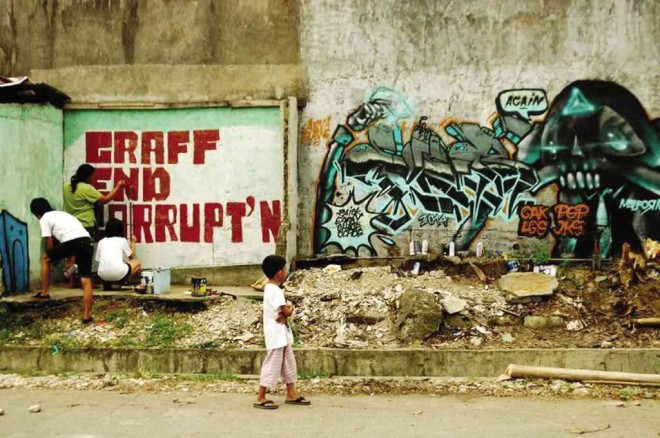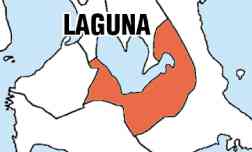
GRAFFITI and street artists in Laguna daub an empty wall in Los Baños, Laguna, to protest corruption in the government. BENJIE VILLARUEL/CONTRIBUTOR
The INQUIRER is coming out today with the 14th of its series on pressing people’s concerns that should be high on the agenda of candidates for representative, governor or mayor in the May 9 elections. The series should help voters in the provinces choose their leaders wisely. In line with our “ThINQ. Vote.” advocacy, we have asked candidates in certain provinces, cities and congressional districts to outline their concrete plans of action in dealing with specific issues in their areas.
Profile: Laguna province
LAGUNA province’s proximity to Metro Manila (about 30 kilometers) has drawn tourists and business investors, spurring the local economy. With 18 industrial estates, it has also adopted the monikers “Detroit of the Philippines,” for hosting major vehicle manufacturers in the city of Sta. Rosa, and the “Silicon Valley of the Philippines,” for its electronic and semiconductor companies. It is the largest province in Calabarzon (Cavite, Laguna, Batangas, Rizal, Quezon) or Region 4A), and an emerging economic hub in Southern Tagalog.
Despite Laguna’s thriving industries, a large part of the province remains agricultural. It has 60,624 hectares of alienable and disposable agricultural land and is known for producing lanzones, rambutan, papaya, mango and pineapple.
In 2012, it produced 120,953 metric tons of rice and 114,450 MT of coconuts. A total of 41,253 ha (23.44 percent of its total land area) are forest land while its eastern portion is surrounded by the Laguna Lake, the largest inland lake in the Philippines.
Land area: 175,973 hectares
Population: 2,473,530 (National Census, 2007)
Registered voters: 1,440,660
Political subdivisions: 4 congressional districts and lone district of Biñan,
6 cities, 23 towns, 674 barangays
Sources: Laguna provincial government website and NSCB
CONCERN 1: FLOODING
SAVING LAKESHORE TOWNS The P122-billion Laguna Lakeshore Expressway Dike (LLED) is envisioned to serve both as an alternate route to decongest traffic and as a flood mitigation structure. The national government is set to award the LLED project, amid criticisms that such a heavy structure could bring catastrophic destruction should a strong earthquake strike. What is the best solution to the heavy siltation of Laguna Lake in order to address the threats of flooding in the lakeshore communities?
Emilio Ramon “ER” Ejercito III, United Nationalist Alliance
- The permanent solution to the problem is to provide an outlet for the water in times of heavy rains.
- Dredging and desilting should still be continued to restore the lake to at least half of its depth.
- The massive reforestation project using bamboo along the lakeshore towns should be undertaken.
- Dismantle fish pens to provide, and ensure free, safe and unimpeded navigational lane for the proposed ferry boat transport circulation system in the Laguna Lake and all the way to Pasig River and vice versa.
- Relocate informal settlers living along the lakeshore to government resettlement areas.
- Stop pollution of the lake to prevent further siltation and to protect its remaining marine habitat.
HERNANDEZ
Ramil Hernandez, Nacionalista Party
- Reduce the effect of its primary causes such as soil erosion, improper solid waste management, and informal settling on shore land.
- Develop and implement the 10-year provincial waste management plan.
- Provide permanent and low-cost housing and relocation sites for informal settlers and communities away from flood-prone areas.
- Conduct massive tree-planting activities, especially in cities and towns along the Laguna de Bay’s tributaries to prevent soil erosion.
- Hold regular clearing of waterways and coastal cleanup activities.
Nemesio Sucano, Independent
- Continue the billion-peso project, but discuss first what we can do to protect our people.
- Create a group that can lead efforts to clean the entire lake. I will call this project “Puso Para sa Lawa,” which is a call to all Lagunense to discipline themselves and help free Laguna Lake from wastes.
CONCERN 2: URBANIZATION AND INDUSTRIALIZATION
BALANCING GROWTH Laguna province, being the gateway to Metro Manila, has become one of the populous and semiindustrialized areas in the country. At a glance, Laguna can be divided into two areas: the urbanized first two districts and the lone district of Biñan, and the agricultural areas in the third and fourth districts. What are your programs on urban planning and industrialization, without compromising the agricultural sector of the province?
Ejercito
- Implement a balanced development in Laguna … Land use should be properly rationalized.
- Strengthen the Provincial Planning and Development Coordination Office and the Provincial Urban Development and Housing Office with the hiring of experts and training of its personnel.
- Stop indiscriminate land conversion.
- Undertake produce matching in agriculture, which is similar to job matching in education. Initiate training of farmers to produce not just palay but products that are sought and command higher prices.
- Undertake upland development.
Hernandez
- Implement the “Timely Agricultural Development and Food Security Program,” which aims to maintain the stability of agricultural security, agro-ecotourism and food security in the third and fourth districts, while the first and second districts embrace urbanization and industrialization.
- Strict compliance with land use and urban planning, particularly the strict enforcement of conversion of agricultural land to other uses.
- Review and define administrative orders regarding the reclassification of agricultural lands
- Intensification of laws regarding land conversion and reclassification
- Sustainable land use and management plan of local government units
- Intensification of population policies and management in urban areas.
Sucano
I make it a point that I optimize the community’s land use and infrastructure … We should stick to the land use and zoning development of each municipality. What is for agriculture is for agriculture.
CONCERN 3: PEACE AND ORDER
ADDRESSING COMMUNITY SAFETY In recent months, Laguna has been constantly in the news due to reports of crimes and illegal drugs. While one may say these were isolated cases, what is your program on peace and order to ensure public safety and buoy investor confidence?
Ejercito
- Revive the Laguna Shield Emergency Response 911 which intensified the implementation of crime prevention and intervention and disaster risk reduction and preparedness campaigns.
- Aim for the ideal ratio of one policeman to every 1,000 residents.
- Initiate new anticriminality operations and programs to fight vehicle theft, organized crime groups and illegal logging.
- Relaunch our “No to Kotong” drive.
- Revive the holding of regular sports and physical development and summer job, placement and training programs for the youth to keep them away from vices.
Hernandez
- Implement operational plans such as intensified province-wide Commission on Elections checkpoints and the “Oplan Bakal” and “Balik Baril” programs.
- Intensify province-wide “Oplan Sita,” mobile/beat patrol, intelligence focused police operations.
- Design and implement operational plans to prevent vehicle theft; possession of illegal firearms; and stop murder, robbery, theft, physical injury and drug-related cases.
- Increase police visibility, especially in hot-spot areas such as Calamba, Cabuyao, San Pedro, Sta. Rosa, San Pablo, Los Baños and Sta. Cruz, where most commercial and other business establishments are located.
Sucano
I will inculcate in the minds of every Lagunense that there is no perfect place or society; cooperation among all the people in the community is very important.
We should be vigilant to report to authorities anything that relates to illegal drugs and crimes.
Editor’s Note: The Inquirer tried to reach the fourth candidate for governor, Berlene Teodoro Alberto of Partido Bagong Maharlika, by sending him a letter and a copy of the questions. The courier service tried thrice to deliver the mail to the Alberto family’s house in San Pedro City, but Alberto’s son refused to accept it.
(Interviews by Maricar Cinco)


